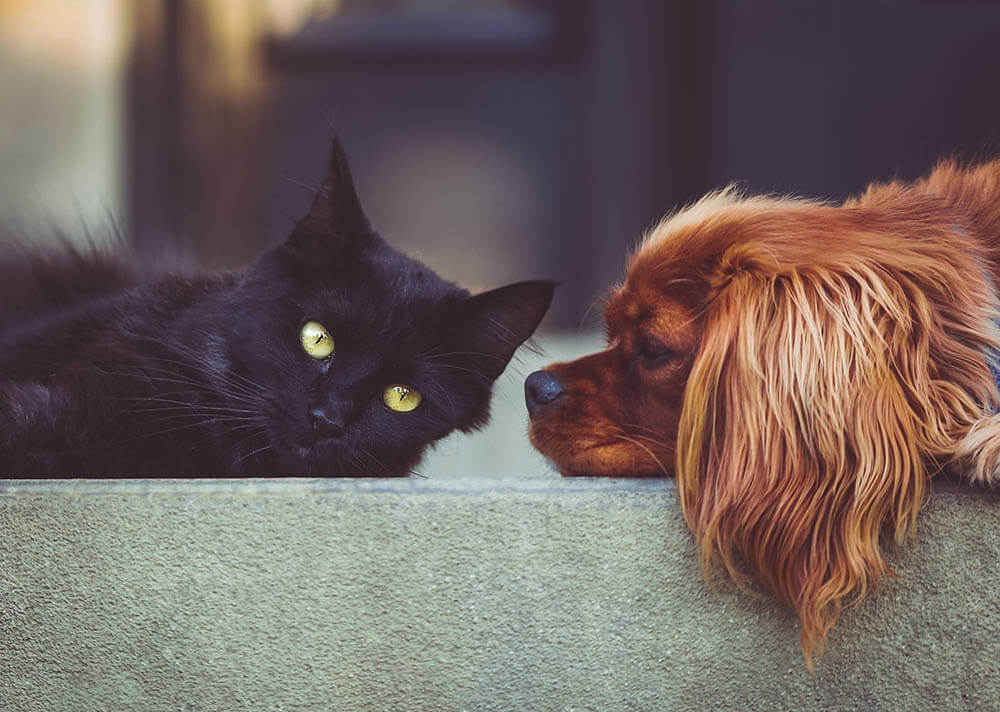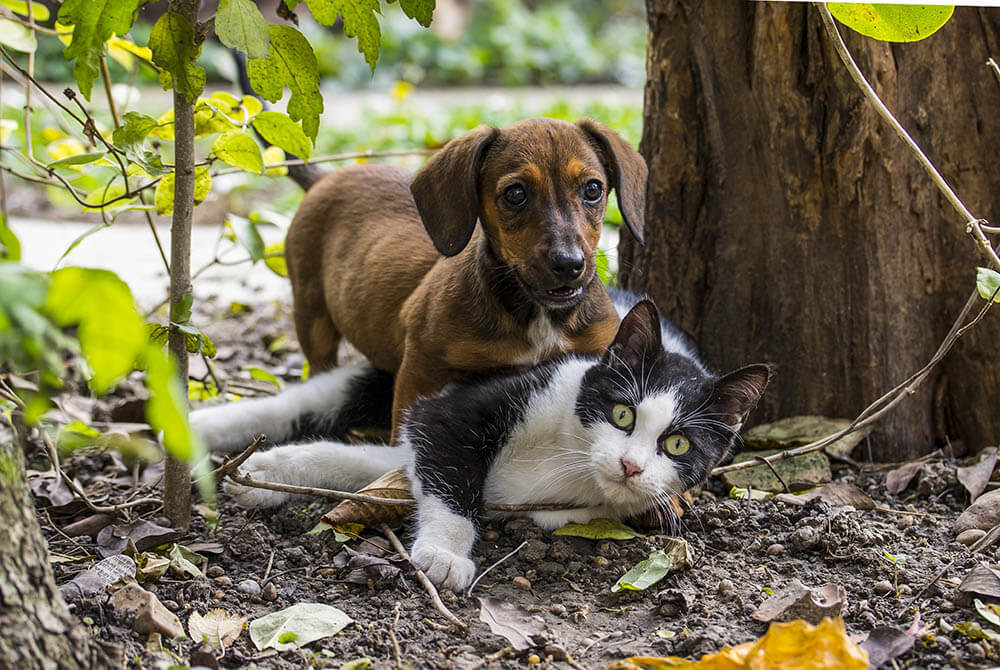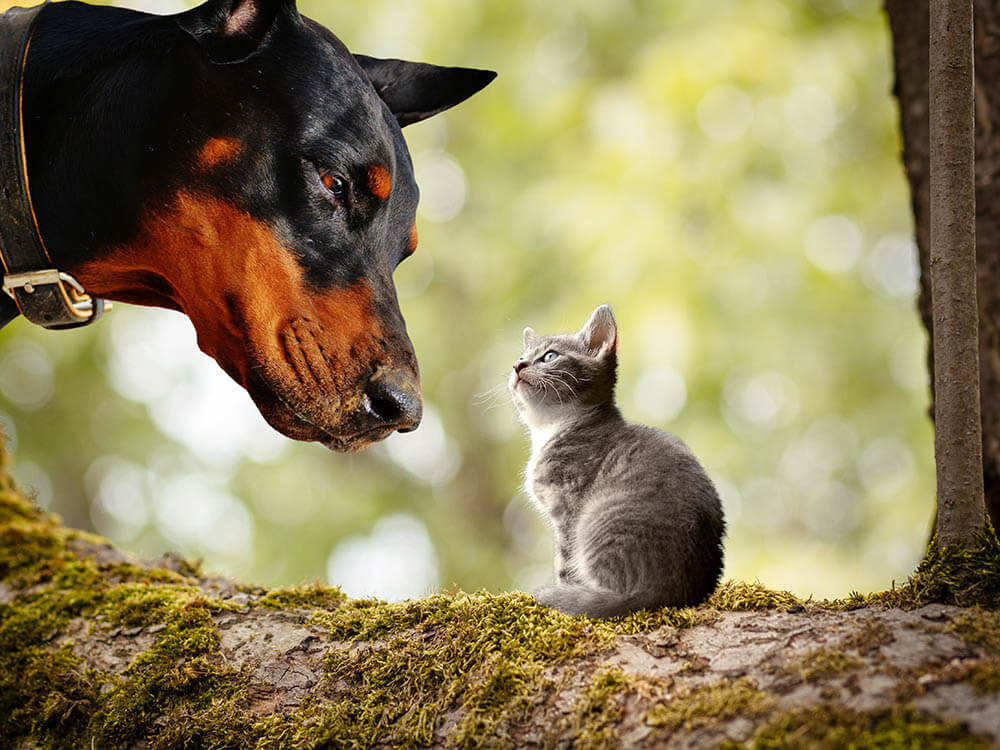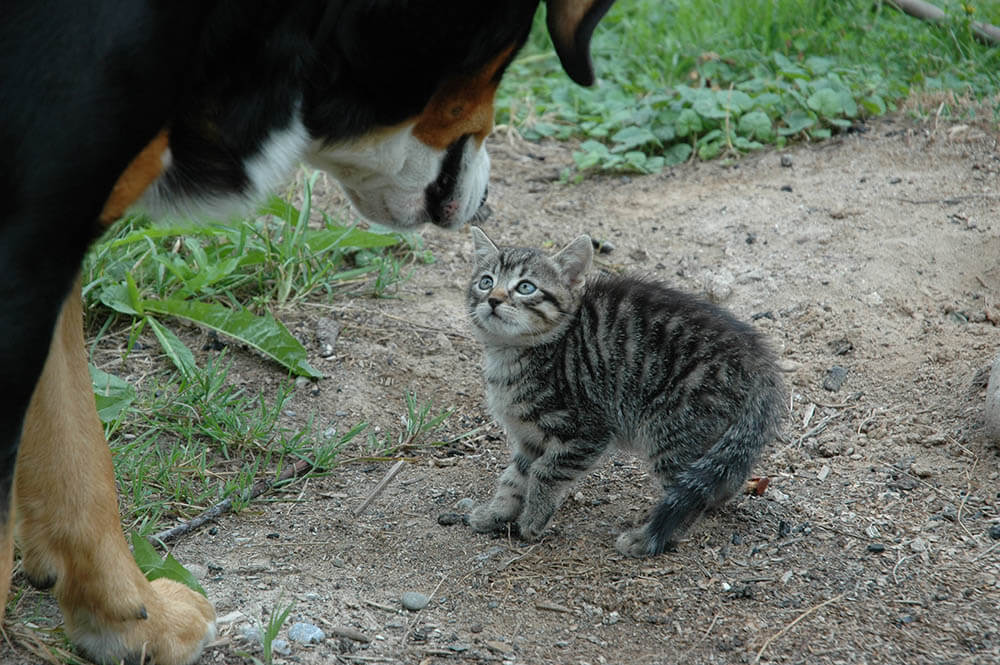The image of a dog chasing a cat is something that comes naturally to us whenever we think of these animals. This isn’t surprising. After all, the canine-feline rivalry is something most people are aware of since childhood.
But have you ever wondered about the real reason behind a dog’s cat-chasing behavior? And can this behavior be prevented?
Read on to find out!

7 Main Reasons Why Dogs Chase Cats
Below, we discuss the 7 main reasons behind dogs’ cat-chasing behavior.
1. Predatory instinct
For thousands of years, wild canines had to chase down and kill prey to fill their bellies. Well, the instinct to hunt hasn’t completely left the modern domesticated dog. This explains why they get extremely excited and give chase whenever they see a smaller animal speed away from them.
Of course, this doesn’t always mean a dog means to kill and eat the cat they’re pursuing. If you’ve raised your dog with cats, or if you’ve trained them not to hurt other animals, then the “hunt” starts and ends with the chase – no murdering required!
In some dogs, the prey drive is so powerful that they’ll rush after any fast-moving thing, from other animals such as squirrels, birds, and people to non-living objects such as tennis balls and cars.
Dogs bred to hunt (i.e. breeds that have retained a strong predatory instinct) are more likely to chase cats than others. Examples include Golden Retrievers, Jack Russell Terriers, English Terriers, American Foxhounds, and American Pit Bull Terriers.
On the other hand, dogs with a lower prey drive – such as French Bulldogs, Pomeranians, and Papillons – are less likely to pursue a fleeing cat, though they still enjoy running.
A strong prey drive is a challenge to curb, but it can be done with patience and appropriate training. If you’re not up to the task, seek help from a professional animal behaviorist or dog trainer.
2. Territorial defense
Dogs can be extremely possessive of their territory; if they feel another creature is trying to steal said territory from them, they’ll use aggression to keep the offending animal away.
So if a cat enters their backyard, expect a territorial dog to bark, growl, and charge at the cat. If the cat doesn’t escape, they could get bitten or worse, mauled to death.
A lack of socialization during puppyhood can make dogs prone to aggression. However, there are other problems – such as anxiety and underlying medical issues – that can make a dog behave this way.
If you have such a dog, you should have a vet and animal behaviorist examine them. These professionals can determine the root of your dog’s troubling behavior, then develop strategies to prevent it from recurring before they can hurt an animal, human, or themselves.
3. Play behavior
As previously mentioned, dogs don’t always chase cats with the intention to devour them. In many cases, a dog that’s running after a cat is simply having fun. Running, after all, is one of the most pleasurable activities for our canine pals.
In other instances, dogs just want to play. If your dog is naturally friendly, they’ll chase your feline pet to get them to play a game with them. You can expect this kind of behavior from extremely playful dogs and especially puppies.
Unfortunately, cats are solitary creatures that like being left alone; sharing a home with an excitable, overly playful dog can give a cat anxiety issues. Thankfully, most puppies outgrow this excessive playfulness, while adult dogs can be trained not to harass cats.

4. Herding
We previously mentioned that dogs bred to hunt game have a strong prey drive and are thus more likely to chase cats. However, dogs bred for herding also tend to run after other animals.
Herding dogs were created to keep animals such as sheep in line. They chase animals not to kill them, but to ensure they stay with the herd and that said herd moves in an orderly fashion.
With training, a dog can learn to curb their herding instinct and leave their feline housemates alone.
Examples of herding dog breeds include the Australian Cattle Dog, Border Collie, Belgian Malinois, German Shepherd, Old English Sheepdog, and Pembroke Welsh Corgi. Take note that some herding dogs also have a strong prey drive.
5. Positive reinforcement
Do you praise your dog every time they chase a cat? If so, then you may have unintentionally trained your dog to chase cats.
Positive reinforcement is an exceptionally effective training technique. It involves rewarding your pet whenever they display desirable behavior. For example, every time your dog sits down when you utter the command “Sit!,” you can give them a treat and/or praise them. Over time, your pet will associate obeying your command with receiving a reward, and will thus keep obeying you in anticipation of that reward.
If you laugh or react in any other positive way whenever your dog chases a cat, they may associate the behavior with gaining your favorable attention. Thankfully, this behavior can be untrained using the right techniques.
6. Attention seeking
Have you been so busy with work that you haven’t been giving your dog any attention? A dog that feels neglected and unloved will seek your attention by engaging in strange, sometimes destructive behaviors.
One dog may stare at you until you can feel their eyes burning holes in your flesh. Another may chase anything that moves – including cats.
Dogs need our attention and affection to stay happy. So make time for your dog; play games with them, cuddle with them, and make them feel loved.
7. Boredom
Without physical and mental stimulation, dogs get bored. And what do bored dogs do? They act out.
Bored dogs will do anything to entertain themselves, including digging, pacing, running away, chewing shoes and furniture, eating things they shouldn’t eat, and, of course, chasing cats and other small critters.
Never let a dog get so bored that they start behaving in ways that can hurt other animals as well as themselves!

Tips on How to Stop Your Dog From Chasing Cats
Chasing cats can get your dog in heaps of trouble. What if your dog catches the cat and maims them? What if the cat fights back and injures your dog? And what if, in the attempt to stop your dog from killing the cat in their jaws, your dog bites you?
Below are a few things you can do to make sure none of these problems happen.
1. Train your dog
With training using positive reinforcement, you can redirect your dog’s behavior so they don’t chase cats.
Whenever your dog wants to pursue a cat, get their attention. The simplest way you can do this is by saying their name with a stern voice, then uttering a command such as “Stop!” or “Leave it!” (your dog should have mastered these commands already). Once you have your dog’s full attention, reward them with their favorite toy or a treat. Ensure you don’t reward them if they’re still interested in the cat.
You can also use a clicker during training. Once your dog turns their attention to you, press the clicker, then reward them. Eventually, whenever they hear the clicking sound, they’ll know to drop whatever they’re doing and turn to you.
Be consistent with your training. Always use the same commands, and always reward your dog at the appropriate time only.
Training takes time and effort, but with your patience and dedication, your dog will eventually get over the need to run after cats.
It’s best to give dogs socialization training while they’re still puppies to prevent aggression in adulthood. However, keep in mind that adult dogs can also be trained to be well-behaved towards cats.
2. Leash your dog
If you’re bringing a cat home, make sure your dog is leashed when you’re introducing them to each other. This will prevent your dog from lunging at and possibly hurting the cat. Use this opportunity to train your dog (using positive reinforcement) not to chase cats.
Until your dog learns to leave the cat alone, keep them separated (baby gates can help), and leash your dog anytime they have to share a room.
When walking your dog, keep them leashed at all times. This will prevent cat-chasing as well as other behaviors that could hurt your dog, such as running at top speeds until they get hit by a car. Only extremely disciplined, exceptionally well-trained dogs can be walked without a leash.
3. Keep your dog physically and mentally stimulated
Boredom is often the culprit behind unacceptable behaviors such as chewing the furniture and chasing things that shouldn’t be chased.
For this reason, every dog owner should give their dog lots of physical and mental exercise.
Walk your dog daily. This allows them to take pleasure in a host of exciting mind-nurturing experiences, such as new scents, sounds, and sights – not to mention walks let them release all their pent-up energy. In addition to walks, you can play games with your dog, take them to pet-friendly locations where they can meet other dogs and humans, and go hiking together so they can enjoy nature with you.
Don’t forget to give your dog toys. Puzzle toys and games are particularly effective anti-boredom tools as they get your dog’s brain working. You should also use those toys to play with your dog.
When you keep your dog physically and mentally stimulated, you also spend time with them. This does more than alleviate their boredom; it also makes them feel you’re giving them the loving attention they need.
4. Seek help from professionals
A vet and animal behaviorist can get to the bottom of your dog’s behavioral problems, then determine the best way to help them.
If a medical concern is behind your dog’s aggression, veterinary treatment can restore them to health and improve their behavior. Anxiety issues can also be treated using anti-anxiety medication.
If your dog’s problems are purely behavioral, an animal behaviorist or dog trainer can put your pet through a training regimen designed to weed out aggression and other issues. These professionals can even help you become a better dog trainer and parent.
For the above reasons, contact a professional for help when you can, especially if you’re having trouble helping your dog on your own.

Conclusion
Dogs chase cats for various reasons – some of them innocent, others a little more worrying. If your dog’s behavior isn’t controlled, they may end up hurting another animal or even themselves.
Thankfully, there are ways to put an end to this behavior, including training your dog, leashing them, and ensuring they get lots of physical and mental exercise. All these strategies take effort, but know that with your love, determination, and patience, your dog can become the loveable, cat-friendly pooch they’re meant to be.
